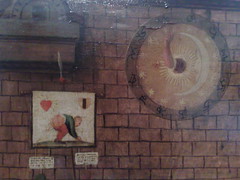Yet another parallel between creationism and mythicism is written up in another of James McGrath’s posts attempting to liken Jesus mythicism to Creationism: Accusations and Assumptions: Another Mythicist-Creationist Parallel.
MYTHICISM
E. P. Sanders (or insert other New Testament scholar or historian here) writes a bookexplaining why he believes the temple incident reflects an actual historical event.
Mythicists continue to say “The historicity of Jesus is merely an assumption historians and scholars make, none of their work actually addresses whether Jesus existed.
I have promised James McGrath a post detailing a response to what E.P. Sanders writes in Jesus in Judaism about the “Temple Action” of Jesus, and the criteria or methodology Sanders addresses. In the meantime, let me point out the fundamental flaw in this complaint by James. If James fails to see it, presumably others fail to see it, too.
Yes, certainly Sanders does explain why he believes the temple incident reflects an actual historical event. He explains most cogently that some such event is the only thing that makes sense of the overall plot of the gospel narrative, as well as subsequent references (those made at his trial and crucifixion) to “something” he did or said in relation to the temple. (I will cover all this in more detail in a post I plan/hope to write up in the next few days.)
Such a process is NOT addressing the question of the historicity of Jesus. Such a process is ASSUMING the historicity of Jesus, and attempting to understand or make sense of the narratives that are told about him. Perhaps without fully realizing it himself, or maybe he does, E. P. Sanders writes of his methodology on page 4 that it is an attempt “to understand Jesus“. Sanders raises a number of features about the gospel narratives that don’t make much sense as they are told, and writes:
What is needed is more secure evidence . . . which at least points towards an explanation of these historical puzzles. (p.5)
When Sanders does list the “indisputable facts” (p.11) of Jesus’ historical existence, he at no point argues for, or cites any reasons for how we can know they are indeed “indisputable facts”. He only cites the opinions of other authorities, such as Morton Smith, Anthony Harvey and Ernst Käsemann. Sanders’ purpose in his book, as he himself explains repeatedly in his introduction, is to explain the problems that such “indisputable facts” present us. (e.g. why he was crucified — there appears to be no clear historically plausible reason for his in the gospel narratives.)
And when he does present his arguments for this or that detail having some historical foundation, his arguments rest on the assumption that the gospels are “reports” of “traditions” that go back in some sense to (the historical) Jesus. In other words, if one takes Sanders’ arguments for the historicity of this or that incident in the gospels as arguments for the “historicity of Jesus”, one is riding on a circular argument.
A reputable bible scholar such as Burton Mack can argue that certain incidents in the gospels (e.g. the “temple cleansing”) are not historical because (1) their presence can be demonstrated to have been motivated by the need to fulfil a particular plot or theological function in the narrative, and/or (2) they can be demonstrated to be inspired by a desire to flesh out and “fulfil” Old Testament passages, and (3) there is no evidence for their occurrence outside the stories of the gospels.
But for some reason if Jesus mythicists argue along the same lines they are accused by James McGrath as arguing against the mainstream and therefore to be compared with “creationists”!

odd detail of a painting of jesus driving money changers out . . . .
